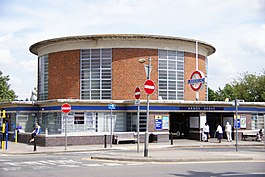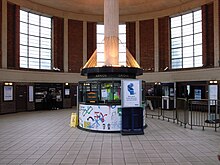
The Piccadilly line is a deep-level London Underground line running from the north to the west of London. It has two branches, which split at Acton Town, and serves 53 stations. The line serves Heathrow Airport, and some of its stations are near tourist attractions such as Piccadilly Circus and Buckingham Palace. The District and Metropolitan lines share some sections of track with the Piccadilly line. Printed in dark blue on the Tube map, it is the sixth-busiest line on the Underground network, with nearly 218 million passenger journeys in 2019.

Bounds Green is a London Underground station, located at the junction of Bounds Green Road and Brownlow Road in Bounds Green in the London Borough of Haringey, North London. The station is on the Piccadilly line, between Wood Green and Arnos Grove stations, and is on the boundary between Zone 3 and Zone 4.

Finsbury Park is an intermodal interchange station in North London for London Underground, National Rail and London Buses services. The station is the third busiest Underground station outside Zone 1, with over 33 million passengers using the station in 2019.

Acton Town is a London Underground station in the south-west corner of Acton, West London, in the London Borough of Ealing, close to its boundary with the London Borough of Hounslow. The station is served by the District and Piccadilly lines and is in Travelcard Zone 3. On the District line, it is between Chiswick Park and Ealing Common stations, and on the Piccadilly line it is between Hammersmith and Ealing Common on the Uxbridge branch & South Ealing on the Heathrow branch. Acton Town station was opened as Mill Hill Park on 1 July 1879 by the District Railway. It remained as a terminus until on 1 May 1883 and 23 June 1903 the District Railway opened two branches from Acton Town to Hounslow Town and Park Royal & Twyford Abbey respectively. On 4 July 1932 the Piccadilly line was extended to Acton Town. District line services to both the Hounslow and Uxbridge branches were withdrawn completely on 9 and 10 October 1964 after which operations were provided by the Piccadilly line alone.

Cockfosters is a London Underground station. It is located on Cockfosters Road (A111) approximately nine miles (14 km) from central London and serves Cockfosters. It is on the boundary of the London Borough of Barnet and the London Borough of Enfield. It is the northern terminus of the Piccadilly line and the next station towards south is Oakwood. The station is in Travelcard Zone 5.

Barons Court is a London Underground station in West Kensington in the London Borough of Hammersmith and Fulham, Greater London. This station serves the District line and the Piccadilly line. Barons Court is between West Kensington and Hammersmith on the District line, and between Earl's Court and Hammersmith on the Piccadilly line and is in Travelcard Zone 2. East of the station, the Piccadilly line descends into tunnel towards Earl's Court and the District line continues in a cutting to West Kensington. The station is the last open air stop for eastbound trains on the Piccadilly line until Arnos Grove and has cross-platform interchange with the District line.

Southgate is a London Underground station in Southgate. It is on the Piccadilly line between Arnos Grove and Oakwood stations and is in Travelcard Zone 4.

South Harrow is a London Underground station in South Harrow, north-west London. It is on the Uxbridge branch of the Piccadilly line between Rayners Lane and Sudbury Hill stations. It is located on Northolt Road (A312). The station is in Travelcard Zone 5. There are several bus stands outside the station as well as overnight train stabling sidings.
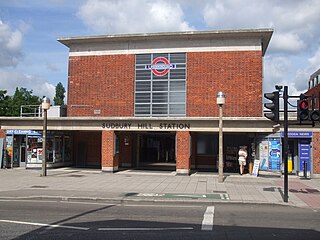
Sudbury Hill is a London Underground station on the Uxbridge branch of the Piccadilly line. The station is between South Harrow and Sudbury Town stations, and is in Travelcard Zone 4. It is located on Greenford Road (A4127) north of the junction with Whitton Avenue, on the border between the London Boroughs of Harrow and Ealing. The station is close to Sudbury Hill Harrow railway station.

Alperton is a London Underground station in Alperton, north-west London. It is on the Uxbridge branch of the Piccadilly line between Sudbury Town and Park Royal stations, in Travelcard Zone 4. It is located on Ealing Road (A4089), a short distance from the junction with Bridgewater Road (A4005), and is close to the Paddington branch of the Grand Union Canal.

Ealing Common is a London Underground station on the Uxbridge branch of the Piccadilly line and on the Ealing Broadway branch of the District line. Eastbound, the next station is Acton Town; westbound, the next station is North Ealing on the Piccadilly line and Ealing Broadway on the District line. Here, the District and Piccadilly lines share the same pair of tracks through the station – the only other example where a deep level line and a sub surface line share the same pair of tracks is further up the Uxbridge branch, where the Piccadilly line shares tracks with the Metropolitan line from Rayners Lane to Uxbridge. It is the only station west of Acton Town to be served by both the Piccadilly and District lines.

Hounslow West is a London Underground station in locality of Hounslow West in Hounslow within the London Borough of Hounslow, West London. The station is on the Heathrow Terminals 2 & 3 branch of the Piccadilly line, between Hatton Cross and Hounslow Central stations and is in Travelcard Zone 5. The station is located on Bath Road, close to the Great West Road (A4). The station has an island platform, with step-free access via a stairlift for manual wheelchair users only.

Boston Manor is a London Underground station at the boundary of the boroughs of Hounslow and Ealing. The station is situated on the Heathrow branch of the Piccadilly line, between Osterley and Northfields stations, in Travelcard Zone 4.

Oakwood is a London Underground station. It is the second most northerly station on the Piccadilly line, between Southgate and Cockfosters stations, and is in Travelcard Zone 5. The station is on the edge of the Oakwood area of Enfield (N14) and is situated at the junction of Bramley Road (A110) and Chase Road. This station has step-free access after the upgrades made to the station between October and December 2007.

Wood Green is a London Underground station. It is on the Piccadilly line between Turnpike Lane and Bounds Green stations and is in Travelcard Zone 3. It is located at the junction of High Road, Wood Green and Lordship Lane. It serves Wood Green Shopping City and the nearby Haringey Council administrative complex as well as a densely populated residential area. It is also the closest tube station to Alexandra Palace.
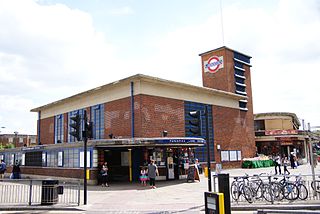
Turnpike Lane is a London Underground station at Turnpike Lane in the London Borough of Haringey in north London, England. The station is on the northeastern part of the Piccadilly line between Manor House and Wood Green. The station was opened on 19 September 1932 as part of the Cockfosters extension. It is in Travelcard Zone 3.
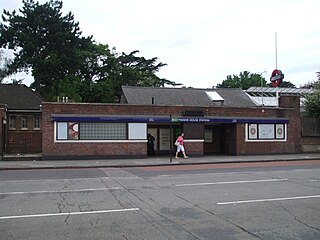
Manor House is a London Underground station. It is on the Piccadilly line between Finsbury Park and Turnpike Lane stations, and is on the boundary between Travelcard Zone 2 and Zone 3. It straddles the border between the London Boroughs of Hackney and Haringey, the postal address and three of the entrances being in the former, and one entrance in the latter.
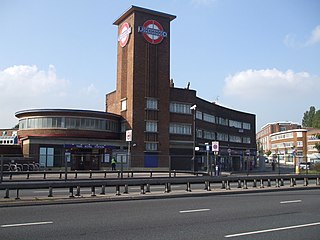
Park Royal is a London Underground station. It is on the Piccadilly line between North Ealing and Alperton stations and is in Travelcard Zone 3. It is situated on the south side of the east–west Western Avenue (A40), surrounded by residential Ealing and industrial Park Royal. There is a pedestrian subway under the A40 road near the station.

Sudbury Town is a London Underground station in Sudbury, north-west London. It is on the Uxbridge branch of the Piccadilly line between Sudbury Hill and Alperton stations, and is in Travelcard Zone 4. It is located on the border between the London Boroughs of Brent and Ealing, with its main entrance on Station Approach in Sudbury. The forecourt of the station is known as Station Crescent. The station serves Sudbury, which forms the western part of Wembley.
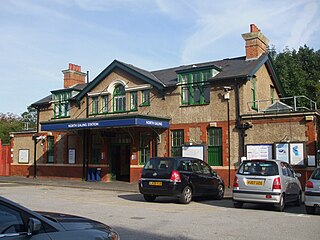
North Ealing is a London Underground station on the Uxbridge branch of the Piccadilly line between Ealing Common and Park Royal. The station is located on Station Road, a short distance from the junction of Queen's Drive and Hanger Lane. It is in Travelcard Zone 3. West Acton station on the Central line is located about 550 metres to the east at the other end of Queen's Drive.
